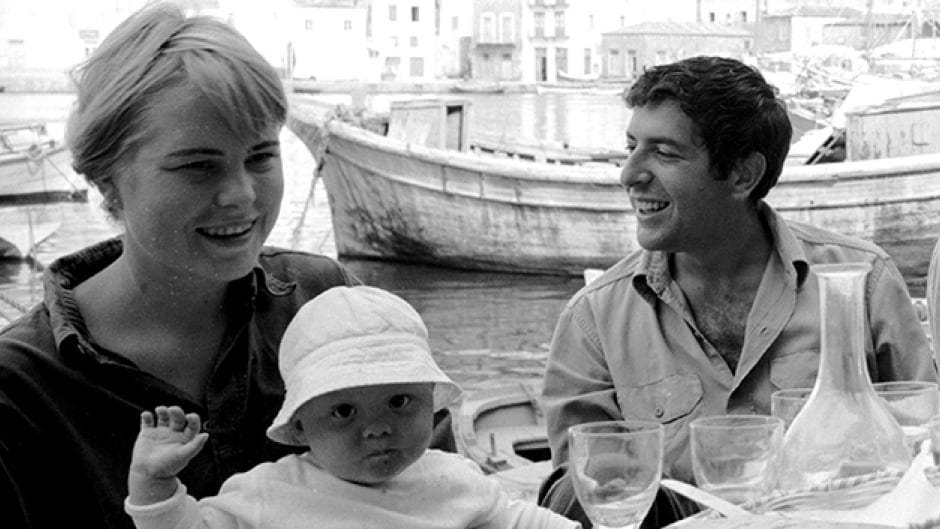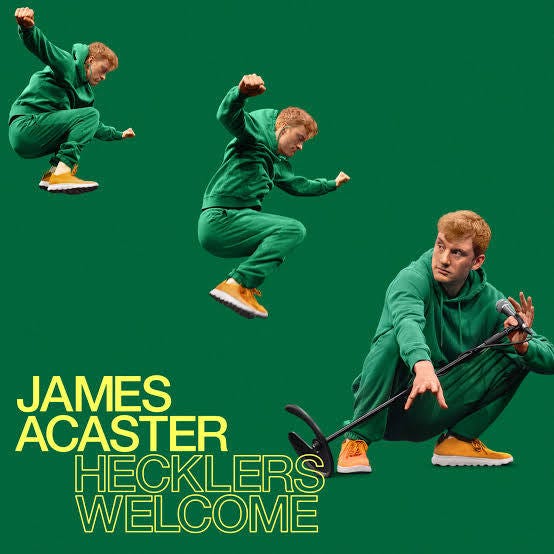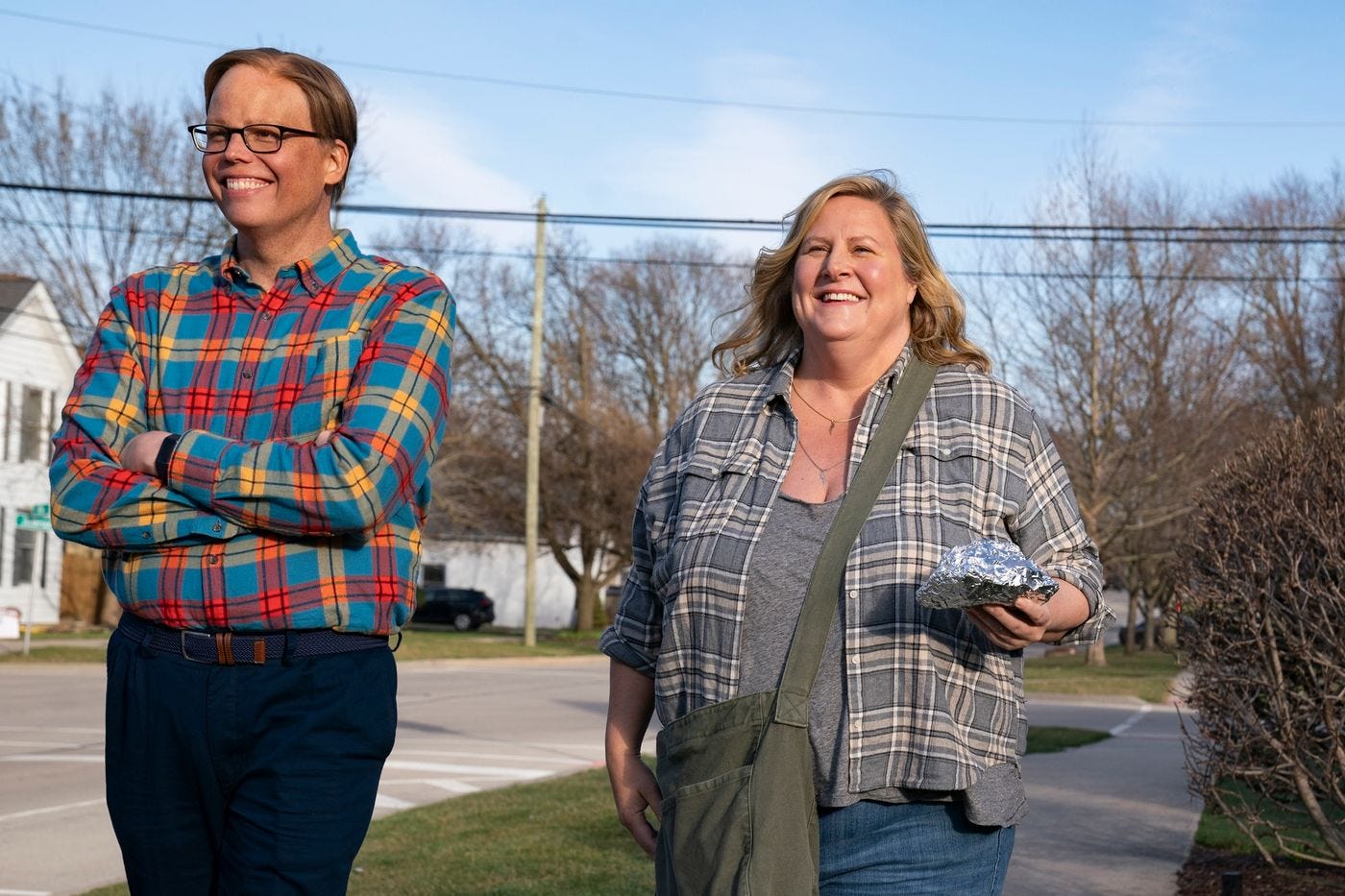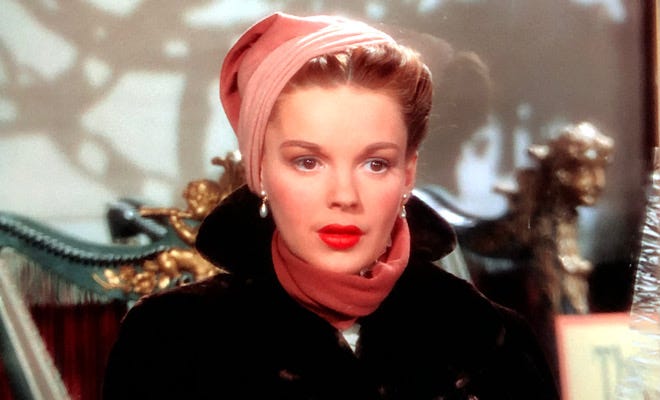Somebodies somewhere, from Hydra to Kettering
TV Sommelier returns with L. Cohen, J. Acaster, Manhattan KS, and Judy, Judy, Judy!
If you’re fortunate enough to have a lot of days off coming up over the holidays, perhaps you’d like some viewing tips for your leisure time. So here’s another round (lighter-hearted than the first two) of picks and pairings from your friendly neighbourhood TV Sommelier.
‘We met when we were almost young’ …
I made my way in fits and starts this fall through the biopic-series So Long, Marianne, a Canadian-Norwegian coproduction about Leonard Cohen’s relationship with Marianne Ihlen, mainly on the Greek island of Hydra in the early to late 1960s. (You can watch it on Crave in Canada—in the U.S. I think you still need to get more creative.) In some ways this pseudo-bohemian soap opera is custom-made for me, but on another level I’m resistant. It is a story I’ve held in my imagination since my early teens, and I admit to feeling irrationally possessive. But also there’s no way to do it justice. Tell it too literally and it’s dumb one way, too loosely and it’s dumb another way. Given that, the show’s not bad, except when it’s awful.
The leads, Thea Sofie Loch Næss (really!) as Marianne and the gawky-but-beguiling Alex Wolff as Leonard, are startlingly good, though too good-looking. The depiction of the art-colony scene on Hydra in the early 1960s is often captivating—you could almost sum up by saying the show’s strong when on Hydra, and scattershot anywhere else. In Montreal, we do get to see great Quebec actor Macha Grenon strikingly incarnate Cohen’s mother. We also have to sit through the bizarre incongruity of Swedish actor Peter Stormare playing the extremely non-Swedish Irving Layton.
The story really falls apart as Marianne and Leonard’s relationship does—in real life, the dissolution took years, as Cohen slowly (sometimes cruelly) pulled away into life as a sixties music celebrity. But that part translates poorly to the screen. Especially in an unforgivably crass scene depicting the encounter with Janis Joplin that led to the song Chelsea Hotel; Cohen always regretted being indiscreet about that story, and he’d feel even worse if he saw it here. Then there are the clunkers of people using lines from songs in dialogue. Not even always Cohen lines—Tom Waits’ “there ain’t no devil, there’s just God when he’s drunk” is oddly attributed to Cohen two decades in advance. It’s the crap filmmakers almost always do when they make stories about writers: Whenever their Leonard writes a goddamn letter, he signs it, “Sincerely, L. Cohen.”
Sadly for a show that claims that it wants to do justice to Marianne as an equal protagonist, it has little specific to add about the impact this “muse” had on Cohen’s work, beyond inspiration and domestic help. She was probably a little bit lost at the time, but given that her ex-husband was also a writer, surely she had her own thoughts about books and such? The show has even less idea of what to do with her in its later chapters. It doesn’t trace how she rebuilt her life, nor the damage libertine Hydra arguably did to her own child and to many people who came through it.
Should you watch? I’d say yes, if you must. You’ll know if it applies to you. I did have to, and I don’t regret it.
Pairings
There are several must-watch items in the Cohen Cinematic Universe. The essential glimpse of the young Leonard is of course in the 1965 National Film Board documentary, Ladies and Gentlemen Mr. Leonard Cohen, depicting a 30-year-old artist not all that acclaimed for anything yet but who still radiated an awkward charisma. Bookend that with the 1972 tour documentary Bird on a Wire, which depicts how much post-Marianne Cohen embraced rock-star excess while maintaining his own rabbinical airs. (Even more extreme is the 1970 Live at the Isle of Wight Festival film, but it’s tricky to find.) Also the more recent documentary about “Hallelujah”—despite the song’s massive overexposure often making me wish never to hear it again—proved surprisingly illuminating.
Closest, of course, is Marianne & Leonard: Words of Love, the 2019 documentary by Nick Broomfield (which is on CBC Gem, Amazon Prime, Apple and other streaming services). Broomfield is the notorious maker of films like Kurt & Courtney, but his approach is gentler here, perhaps because he visited Hydra himself in his youth and became a friend of Marianne’s, post-Leonard. He does account for some of the negative fallout of those days, though he too fails to give as fully rounded an account of Ihlen as one would hope.
Among other films about artists and “muses,” there are several on this list, for instance, I still haven’t seen. And while Marianne was by no means a “groupie,” it’s worth questioning the way we draw that distinction, and I happily recommend the imperfect but revelatory podcast series Groupies, about “women of the Sunset Strip, from the Pill to punk,” which is part of Lost Notes, produced by Jessica Hopper.
Still for me the final word on Leonard and Marianne, even more than the famous deathbed letter, will always be Cohen’s poem “Days of Kindness,” written on a return visit to Hydra in 1985:
Greece is a good place
to look at the moon, isn’t it
You can read by moonlight
You can read on the terrace
You can see a face
as you saw it when you were young
There was good light then
oil lamps and candles
and those little flames
that floated on a cork in olive oil
What I loved in my old life
I haven’t forgotten
It lives in my spine
Marianne and the child
The days of kindness
It rises in my spine
and it manifests as tears
I pray that loving memory
exists for them too
the precious ones I overthrew
for an education in the world
… Now entering the James Acaster constellation …
Hecklers Welcome, the latest standup special from my favourite contemporary UK comedian James Acaster, made its debut last month on HBO (or Crave in Canada). A highly strung eccentric at the best of times, Acaster has always had emotional trouble handling disruptive people in his crowds. During the pandemic, he realized he’d come to dislike doing standup because of it. So as a form of aversion therapy, he decided to do a tour where he gave the audience permission to do what they wanted—if they heckled (short of threats or hate speech), he vowed to take it in stride and incorporate it. As represented on the special, Acaster makes his way through some childhood stories and other material about why he became so insecure in front of audiences. But now and then he has to pivot to the instant feedback from the live crowd, creating a hall of thematic mirrors.
Pairings
But that’s just this version of the show. Any viewing of Hecklers Welcome really needs to be followed by a listen to the live album version (on Spotify, YouTube, Apple and elsewhere). It was taped at a very different stop on the tour, in Acaster’s hometown of Kettering, in the East Midlands. There, the most anarchic possibilities of the concept are fulfilled. Halfway through, Acaster basically has to give up on delivering any more of his prepared material, because the heckling is so out of hand—the stories of the audience members end up forming an entire narrative of their own. He handles it with charming aplomb but you can feel how near his grasp comes to slipping.
Re-Pairings
Hecklers Welcome can probably stand alone, but if you have time, it’s very much enhanced by knowing Acaster’s previous work first. There’s his whimsical, high-concept, interlinked four-part package of specials on Netflix from 2018, Repertoire, which is something of a landmark in modern standup. Then, his more intimate 2021 special, Cold Lasagne Hate Myself 1999, which builds to the serious-yet-absurd tale of Acaster calling a help line after having a nervous breakdown on the set of The Great British Bake Off.
Also, you don’t have to listen, but it helps to know that with his fellow comedian Ed Gamble, Acaster hosts an extremely successful podcast called Off Menu—there, he plays the “genie waiter” serving celebrity guests their dream meals in a “dream restaurant.” (It’s why the most common heckle he gets is “papadams or bread?!”) And failing all else, you should do yourself the kindness of watching all of Acaster’s appearances on the UK panel show Would I Lie to You? (recommended in general), as panelists agonize about whether his ridiculous tales could possibly be true. Maybe start with this improbable account of what passes for seasonal fun in Kettering.
Life was sweet in Somebody Somewhere
You don’t need to take my word—pretty much every TV critic will tell you that this little-watched HBO series that ended with its third season earlier this month was one of the best of the decade so far. Most remarkable to me is that a crew of creators and performers largely out of the raunchy, queer, downtown New York alternative-cabaret scene ended up grounding such a sensitive, funny, hopeful but unillusioned depiction of small-town and rural American life (albeit in Manhattan, Kansas). Also, germane to our interests here at “Crritic!” sometimes it bursts into song.
Pairings
It’s hard to come up with tonally fitting analogs for Somebody Somewhere. But with its utterly lived-in and painfully emotionally precise performances, plus its interest in pretty much nothing other than socially situated character, I did sometimes think of British director Mike Leigh. Especially his almost-affectionate films about working-class family life, High Hopes and Life Is Sweet. I haven’t seen this year’s Hard Truths yet, but I was glad it occasioned this survey of Leigh’s work from Vulture, which usefully locates each film on a spectrum from crushingly depressing to glumly amusing. If you aren’t familiar with the complex process of actor-centric improvisation and development Leigh uses to write his films, that’s a deep rabbit hole you can follow—Sarah Larson’s current New Yorker interview can give you a start.
All the Shops around the Corner
To end on a seasonal note: Many of you probably know that one of the greatest Xmas movies and romantic comedies ever is Ernst Lubitsch’s 1940 The Shop around the Corner with Jimmy Stewart and Margaret Sullivan as store clerks in Budapest (!) who don’t know the co-worker they’re always fighting with is also the anonymous penpal they’re falling in love with. If you have not seen it, please make this the year you do.
You may also know that the 1998 Meg Ryan and Tom Hanks vehicle, the early-Internet-relic (and when-bookstores-mattered relic) You’ve Got Mail, was inspired by The Shop around the Corner—which becomes the name of Ryan’s New York indie bookstore in the flick, under threat from Hanks’s Barnes-and-Noble-ish company, way pre-Amazon. From what I remember, it’s good but a notch down the Nora Ephron scale from When Harry Met Sally and Sleepless in Seattle.
But all of this is an excuse to tell you that this week I met the third point on the Shop triangle for the first time. Made just nine years after the original, MGM hack Robert Z. Leonard’s 1949 semi-musical In the Good Old Summertime takes place across a year in early-20th-century Chicago, starring Judy Garland and Van Johnson as workers/unwitting penpals in a music store. Among other plot developments, this gives Garland multiple chances to sing tunes as “demonstrations” to potential sheet-music clients. One of them, at a very emotional juncture, is the song “Merry Christmas,” which is the penultimate track on my “Yule Be Nice” playlist this year.
Pairings (kinda)
That barely begins to describe all the things that happen in this movie.
Garland also does an incredible rendition, for almost no reason, of the vaudeville hit “I Don’t Care!” by forgotten superstar Eva Tanguay1, who Jody Rosen has called the Madonna of the early 1900s.
Then there’s the fact that one of Garland and Johnson’s co-workers—playing the nephew of familiar character actor S.Z. Sakall as shop owner Mr. Oberkugen—is none other than Buster Keaton.
At first I found it sad Keaton was wasting his time playing this side character for the studio that had fired him as an auteur 16 years earlier. But then I was informed by my Slate colleague and pal Dana Stevens—the author of the great Keaton book Camera Man—that Keaton more or less ended up directing the main sequences of physical comedy, which Leonard wasn’t competent to do. See the leading characters’ “meet-cute,” for example. when Johnson runs into Garland on some stairs and knocks off her hat. Said chapeau is decorated by a fake bird, and in his scramble to make amends Johnson accidentally picks up a live pigeon as a replacement. That’s the Keaton touch, no doubt.
Granted, Good Old Summertime may still rank below You’ve Got Mail in the Shop pantheon. But watch it (after the original) for all the reasons above—plus, in a moment I won’t spoil, the first ever screen appearance of Liza Minnelli.
Somehow I spelled this earlier as “Yves” Tanguay, like she was Yves Klein or something. It was late, there was wine involved.







There are a few too many things in this one that I *have to see* (or hear)! I’ve never heard of the Judy Garland film though I do love The Shop Around the Corner! And this recommendation is surely the one that tips me over the edge to Somebody Somewhere. Not sure why I was resistant in the first place other than that there’s too much out there to see. Let’s not even start with the Leonard Cohen stuff, that’s all mandatory, and even seasonal for me, because we always listened to his records at home at Christmas time.
p.s. curious to hear your thoughts on Hard Truths when you do see it.